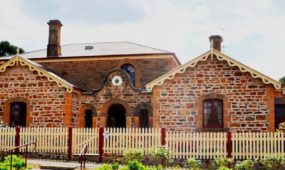X-ray technology helps map indigenous artefacts
Arts
X-RAY technology used to analyse Indigenous Australian ochre artefacts could be used to accurately map the origin and techniques of indigenous art from around the world.

Sign up to receive notifications about new stories in this category.
Thank you for subscribing to story notifications.
Researchers from Flinders University in South Australia have managed to use advanced X-ray technology from the Australian Synchotron Facility in Melbourne to analyse Aboriginal artefacts without the need for sample extraction.
Old European-style portrait artworks have been analysed using X-ray fluorescence microscopy, but the new research allows for more delicate artefacts like bark paintings to be examined while remaining intact.
Flinders University researcher Dr Rachel Popelka-Filcoff said although the technique had been used in European-style canvas paintings, this was the first time it was used on Indigenous objects.
“This new method provides higher resolution information and an alternative to traditional destructive testing, while returning the object unharmed to the museum collection,” she said.
“In the case of investigating the fine lines and dots in many Indigenous objects, this technique has unparalleled resolution over other existing techniques.
“The compilation of these data into elemental maps allows further insights into the composition, application and layering of natural pigment on the micron scale, and further cultural interpretation of the objects, as well as expanding the capability of the (synchotron beamline) technique towards complex analytical problems.”
Using the XFM beamline at the Australian Synchotron in Melbourne, Dr Popelka-Filcoff joined South Australian Museum and University of South Australia researchers in analysing two different Australian Indigenous objects, a boomerang and bark painting from the museum’s Australian Aboriginal Culture Collection.
“The findings from across Australia will help to reconstruct ancient exchange routes, provenance of Indigenous art and objects, and other unprecedented analysis to help conservation and authentication studies,” Dr Popelka-Filcoff said.
“We have been looking at the bulk analysis of these pigments from known sources, but there hasn’t really been any work done on the really fine paintings. The technology had not really been there to examine them.
“At the Synchotron we are able to do things with a spot size of about 5 microns or less. We can create an elemental map of the pigments on the object that gives us an idea of the composition and structure of the pigments, how they were applied and the thickness.
“There is no need for a vacuum, no need to take physical samples, and we get a wealth of information.”
The high sensitivity x-ray fluorescence detector allows for a low radiation dose, returning larger amounts of data than other traditional X-ray methods.
Experts gain accurate data on the composition of the mineral pigments without disturbing the object, enhancing the studies of Indigenous technology and culture conservation.
“One of the reasons we are so excited to have this published is because it’s not just important in understanding indigenous cultures in Australia, but to understand indigenous cultures worldwide,” Dr Popelka-Filcoff said.
The latest findings have been published by the Royal Society of Chemisty in its high-ranking analytical chemistry journal and Emerging Investigators issue.
The research is a collaboration between Flinders University, the Australian Synchotron in Victoria, SA Museum and University of South Australia.
Flinders University is one of three long-standing public universities in South Australia’s capital, Adelaide, along with the University of South Australia, and the University of Adelaide. All three universities are consistently rated highly in the international higher education rankings.
Jump to next article



